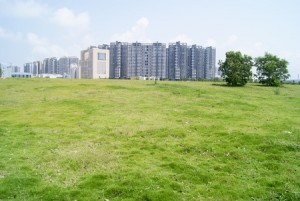
Within the past few decades, climatologists have discovered that urban development significantly alters climate. In part, this is because heat islands exist around urban areas as large numbers of homes use heaters in winter. The heat escaping from homes warms the surrounding air. The more homes there are, the greater the effect on temperature.
In summer, expansive tracts of concrete and a corresponding reduction in vegetation result in hotter days and warmer nights.
In the San Joaquin Valley, the increase in temperature in winter has resulted in drier winters as fog forms less frequently. The warmer temperature results in greater evaporation and a drier climate. In summer, hotter temperatures in the cities have a similar effect in drying out the region.
Urban residents are presently being urged to pull out their lawns and replace them with rock and other landscape that does not require the use of water. Doing so will speed up desertification and the water savings will be less than people think. One study has shown that even Los Angeles, with its huge population, will save less than most people think by lawn removal (See “Lose the Lawn” here; scroll down for the article).
As people pull out their lawns, water run-off from storms will increase. Less water will soak into the ground. The climate will grow warmer and drier as less vegetation will exist to help moderate the temperatures.
A better idea would be to keep the lawns. The grass will grow back when the rains return. Lawn maintenance is greater with a lawn, but the effort is worth it.
Farming Affects Climate
Farming practices in the Southern San Joaquin Valley have been blamed by some climatologists for the desertification of that part of the valley. Lakes, ponds and rivers were all drained so that the land could be farmed.
Bodies of water create their own microclimate. As an example, land downwind of Lake Erie annually receives much more snow than land on other sides of the lake. The phenomenon is called “lake effect” weather. Bodies of water also cool the air when the water evaporates.
When the bodies of water in the southern San Joaquin Valley were drained, warming and drying increased because of the reduction of the lake effect.
Irrigation practices also increased the amount of runoff into rivers and streams, gradually drying out the land. Over time, the combination of farming and the gradual change of climate to warmer and drier have made the already arid southern San Joaquin Valley even drier. The only mitigating factor is irrigation.
The desert may be spreading north to Stanislaus County. As the climate gets warmer, the County seems to get drier. As water becomes scarcer, farmers are turning to crops requiring less water. As less water is used, the land becomes drier. As the land becomes drier, the climate becomes drier due to a reduction in evaporation.
Stopping Desertification
Given the fact that desertification in Stanislaus County appears to be ongoing, one would hope that scientists would find a way to stop it. Unfortunately, many things we do in the name of economic development seem to make the problem worse. Therefore, anything scientists eventually propose may be unpopular and ignored.
The best solutions are rather obvious, but are they going to happen?
First, climate may change to a wetter regime. Nature may do the job. This is the simplest and easiest solution. However, man has not figured out how to control nature, so this solution will probably occur at random. This is most likely to occur if we enter another ice age.
Second, we can import water. Rather than allow the area to become a desert, we can pipe in enough water from areas that have a surplus to stop further desertification. This would be an expensive alternative, but probably can be done.
Third, we can recycle water. Recycling helps retain water within local ecosystems.
Finally, we can make water. The water would come from desalinization plants along the coast and could be shipped inland as needed. Better yet, allow us to keep all locally occurring water, including water from the mountains, and have coastal communities make the water they need.
As long as the rain does not fall, the last three ideas are the best bet for stopping desertification of Stanislaus County. The other alternative is to do nothing and live on less water. While this is feasible, less water does not lead to a better life.
